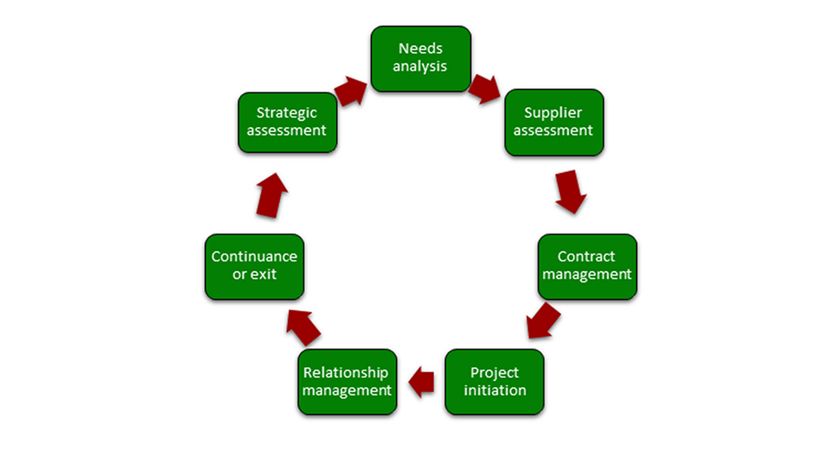Outsourcing implementation – The how and when of success
In many cases, companies hire contractors either to have specific types of work done, or to reduce their workload. In this manner, long-term relationships are established with the companies whose capabilities complement or supplement their own.
There are many whys and wherefores that might influence a company to outsource, namely:
- The identification of a better capability within the other company;
- Freeing resources for other purposes;
- Operating costs reduction and control;
- Infusion of cash by selling assets to provider;
- Risk reduction;
- Lack of internal resources;
- Desire to focus more tightly on the core business;
- Economies of scale;
- Benchmark;
How to? The outsourcing life cycle
Using a process-driven approach when outsourcing provides a systematic look at the “how-to” details of developing an outsourcing plan. Specific steps need to be followed to ensure that the company is being thorough in the outsourcing relationship management. Although the components of the outsourcing process do not change over time or between projects, the change comes from the process’s effectiveness and efficiency.
The framework should be used to move through outsourcing engagements and improved for better results. The outsourcing life cycle is made up of six stages. Each of them has sub-components and sub-processes where extra attention is needed:
- Strategic Assessment: for effective outsourcing, the initiative must be evaluated in the context of the company’s strategic position.
- Needs analysis: after completing the strategic assessment, the project solutions have to be identified as suitable for outsourcing. This involves prioritizing the company’s needs by conducting a thorough needs analysis.
- Supplier assessment: this stage is one of seeking, evaluating and choosing the vendor for the outsourcing needs. The vendor selection and contracting phase provides a structured framework to guide the company through critical supplier selection and contracting activities. Choosing the right supplier is very important as the chances are that if the company makes the right decision from the beginning, the relationship will be a potentially lasting one, while choosing the wrong supplier could damage and ruin a well-intentioned outsourcing project.
- Contract management: once a vendor was chosen, the next steps are to engage in negotiation and to reach an agreement about the details of the outsourced process. This is followed by configuring the outsourcing contract.
- Project initiation: this stage is the one where the Procurement department is the mostly involved in. All materials are now delivered to the subcontracting company, issues are solved with the help of all involved departments, the outsourcing relationship is formed and the effectiveness and efficiency of the process are measured. This stage’s focus is on keeping up to date with the outsourcing relationship. The relevant activities include evaluation of the relationship, problem resolution, communications management, knowledge management and process management.
- Continuous modifications and exit: before implementing the outsourcing project, some critical points need to be made. This process is a cyclical one and it is important to follow through on each step in an organized manner. One of the reasons it is recommended to follow the steps in a structured way is that this greatly reduces difficult decision making while moving through the process.

When to implement outsourcing
The decision to outsource is very critical when doing business. The following scenarios come to aid when deciding to outsource:- The company needs assistance with a particular function: outsourcing a short-term job would be not only much cheaper, but also easily sustainable;
- The company needs to expand to meet the growing demand and deliver increasing number of orders in time, but there is a lack of infrastructure or resources to drastically upgrade, thus outsourcing is the perfect solution;
- There is a need to start a new in-house process, in a short period of time;
- There is a need to transform an in-house process, situation in which it is advisable to outsource on a short-term basis to allow the change to occur in a stable manner. Once the operations are running smoothly and steadily, it can be transferred back to the company;
- There is a skill shortage in a particular field or a difficulty in finding right candidates or very high pay packages. Moving the workload to skilled professionals who demand lower wages would result in huge savings for the company in terms of costs as well as quality;
- A project or function is being inefficiently performed in-house for any reason: here, outsourcing would cover the company against the operational and financial risks.
- Baily, P., Farmer, D., Crocker, B., Jessop, D. and Jones, D. (2010), Procurement, principles and management, 10th edition
- Leenders, M., Johnson, P., Flynn, A. and Fearon, H. (2005), Purchasing and Supply Management: with 50 supply chain cases, 13th edition
- Power, M., Desouza, K. and Bonifazi, C. (2006), The outsourcing handbook: How to implement a successful outsourcing process

Tags: outsoursing, Strategy






